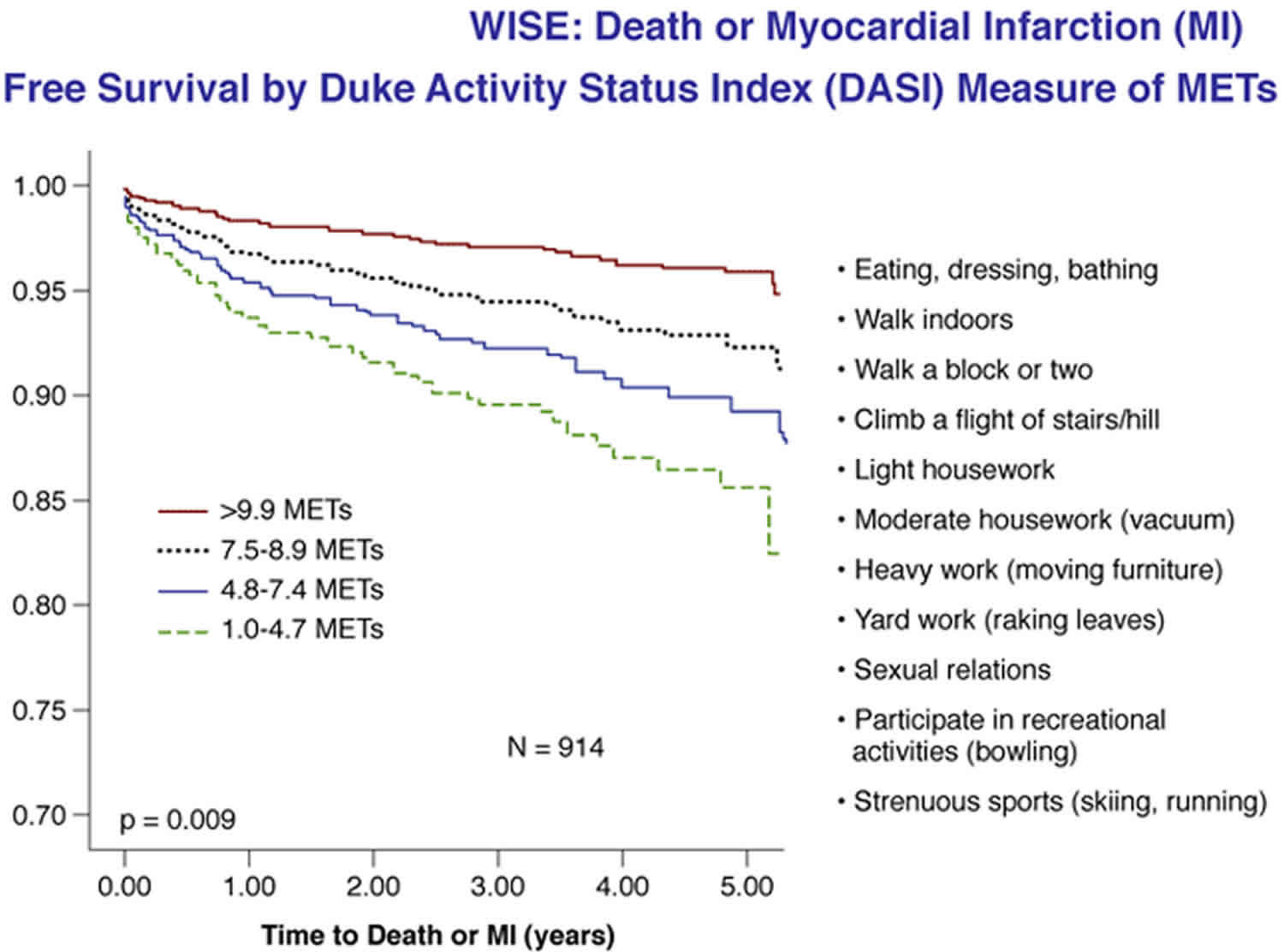Duke Activity Status Index
Duke Activity Status Index or DASI, is a self-administered questionnaire (simple 12-question self-assessment tool) that measures a patient’s functional capacity 1. Duke Activity Status Index can be used to get a rough estimate of a patient’s peak oxygen uptake.
Duke Activity Status Index score correlated well with peak oxygen uptake on exercise treadmill stress testing 1 and are validated measures of treadmill functional capacity measured in metabolic equivalent tasks (METs) 2. The DASI score predicted adverse prognosis in cohort of patients with various types of cardiac disease 3. The lowest DASI score is associated with greater 5-year mortality in patients with established diagnosis of peripheral artery disease 4. However, further study is needed to determine whether interventions that improve the Duke Activity Status Index score also improve prognosis among patients with peripheral artery disease.
The Woman’s Ischemia Syndrome Evaluation (WISE) study 5 showed that the Duke Activity Status Index correlates with indeterminate exercise testing results and is associated with an adverse prognosis among women with suspected myocardial ischemia.
A group has previously reported that among patients with stable chronic heart failure and stable cardiac patients undergoing elective diagnosis cardiac evaluation, Duke Activity Status Index provides independent and incremental prognostic value for mortality prediction 6. In the setting of cardiac surgery, Koch et al. 7 demonstrated that lower Duke Activity Status Index score at perioperative baseline and postoperative follow-up identifies patients who are at risk for reduced long-term survival, and those who achieved a maximum baseline DASI were associated with better risk-adjusted long-term survival. Recent data from the Trial of Intensified versus Standard medical therapy in Elderly patients With Congestive heart Failure 8 further implied that those with changes in Duke Activity Status Index score over 1 year demonstrated stronger association with long-term outcomes than an objective assessment (6-minute walking distance). Previous studies from the Walking and Leg Circulation Study 9 cohort have reported that, greater than 2-year declines in functional performance and Walking Impairment Questionnaire (WIQ) scores were associated with higher all-cause mortality in patients with lower extremity peripheral artery disease. Importantly, home-based walking exercise program improve Walking Impairment Questionnaire score and functional performance in patients with lower extremity peripheral artery disease 10. These findings are supportive of the ability to prevent decline, or improving the DASI score as a potential therapeutic target in patients with peripheral artery disease.
- Can you take care of yourself (eating, dressing, bathing or using the toilet)? YES = 2.75 / NO = 0
- Can you walk indoors, such as around your house? YES = 1.75 / NO = 0
- Can you walk a block or two on level ground? YES = 2.75 / NO = 0
- Can you climb a flight of stairs or walk up a hill? YES = 5.50 / NO = 0
- Can you run a short distance? YES = 8.00 / NO = 0
- Can you do light work around the house, such as dusting or washing dishes? YES = 2.70 / NO = 0
- Can you do moderate work around the house, such as vacuuming,sweeping floors or carrying in groceries? YES = 3.50 / NO = 0
- Can you do heavy work around the house, such as scrubbing floors or lifting and moving heavy furniture? YES = 8.00 / NO = 0
- Can you do yard work, such as raking leaves,weeding or pushing a power mower? YES = 4.50 / NO = 0
- Can you have sexual relations? YES = 5.25 / NO = 0
- Can you participate in moderate recreational activities, such asgolf,bowling,dancing,doubles tennis or throwing a baseball or football? YES = 6.00 / NO = 0
- Can you participate in strenuous sports, such asswimming,singles tennis,football,basketball or skiing? YES = 7.50/ NO = 0
Duke Activity Status Index (DASI) = sum of “Yes” replies ___________
- Positive responses are summed to get a total score, which ranges from 0 to 58.2. The higher the score (maximum 58.2), the higher the functional status.
VO2peak = (0.43 x DASI) + 9.6
VO2peak = ___________ ml/kg/min ÷ 3.5 ml/kg/min = __________ METS
- Hlatky MA, Boineau RE, Higginbotham MB, Lee KL, Mark DB, Califf RM, et al. A brief self-administered questionnaire to determine functional capacity (the Duke Activity Status Index) Am J Cardiol. 1989;64(10):651–654.[↩][↩]
- Bairey Merz CN, Olson M, McGorray S, Pakstis DL, Zell K, Rickens CR, et al. Physical activity and functional capacity measurement in women: a report from the NHLBI-sponsored WISE study. J Womens Health Gend Based Med. 2000;9(7):769–777.[↩]
- Grodin JL, Hammadah M, Fan Y, Hazen SL, Tang WH. Prognostic value of estimating functional capacity with the use of the duke activity status index in stable patients with chronic heart failure. J Card Fail. 2015;21(1):44–50.[↩]
- Senthong V, Wu Y, Hazen SL, Tang WH. Predicting long-term prognosis in stable peripheral artery disease with baseline functional capacity estimated by the Duke Activity Status Index. Am Heart J. 2017;184:17-25. doi:10.1016/j.ahj.2016.10.009 https://www.ncbi.nlm.nih.gov/pmc/articles/PMC5322238[↩]
- Shaw LJ, Olson MB, Kip K, Kelsey SF, Johnson BD, Mark DB, et al. The value of estimated functional capacity in estimating outcome: results from the NHBLI-Sponsored Women’s Ischemia Syndrome Evaluation (WISE) Study. J Am Coll Cardiol. 2006;47(3 Suppl):S36–S43.[↩]
- Tang WH, Topol EJ, Fan Y, Wu Y, Cho L, Stevenson C, et al. Prognostic value of estimated functional capacity incremental to cardiac biomarkers in stable cardiac patients. J Am Heart Assoc. 2014;3(5):e000960[↩]
- Koch CG, Li L, Lauer M, Sabik J, Starr NJ, Blackstone EH. Effect of functional health-related quality of life on long-term survival after cardiac surgery. Circulation. 2007;115(6):692–699.[↩]
- Spruit MA, Maeder MT, Knackstedt C, Ammann P, Jeker U, Uszko-Lencer NH, et al. Prognostic value of self-reported versus objectively measured functional capacity in patients with heart failure: results from the TIME-CHF (Trial of Intensified Versus Standard Medical Therapy in Elderly Patients with Congestive Heart Failure) J Am Coll Cardiol. 2012;60(20):2125–2126.[↩]
- Jain A, Liu K, Ferrucci L, Criqui MH, Tian L, Guralnik JM, et al. Declining walking impairment questionnaire scores are associated with subsequent increased mortality in peripheral artery disease. J Am Coll Cardiol. 2013;61(17):1820–1829.[↩]
- McDermott MM, Liu K, Guralnik JM, Criqui MH, Spring B, Tian L, et al. Home-based walking exercise intervention in peripheral artery disease: a randomized clinical trial. Jama. 2013;310(1):57–65.[↩]





